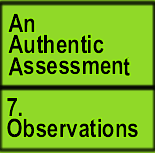Observations
This part of the class was the most challenging only because the semester was “spotty.” By this I mean that in my first-semester as a doctoral candidate — twenty-eight years removed from my masters studies — I had discovered a new world, a world so real that it reared an ugly head and spit forth a plethora of obstacles. I refuse to delve into a litany of woes, so I will simply state that I had to be flexible and create several "work arounds" to participate successfully in this aspect of the class.
My first observation occurred at Novice Teacher's rural Arkansas high school. I sat in on a civics class of 16 students. My interest focused on the Asian and Hispanic students: one Hmong male, one Laotian female, one Thai female, two Hispanic males, and one European-Hispanic. Each of these students demonstrated adequate English skills and participated fully in the class assignment. Novice Teacher divided the students into four groups, and each group created their own political party with symbol, platform, and name. Each Hispanic student was in a separate group, but the Hmong, Laotian, and Thai students were in a group together. I was especially impressed by the Hmong student’s role as leader of his group. He was passionate and articulate. The only errors I heard were the omission of the final "s" in third-person singular and noun plurals. His syntax was fine and his vocabulary extensive. The other students took more passive roles in the groups.
The next observation was at an English language institute on the university campus. I observed three classes of upper-level fluency: reading, writing, and listening/speaking. These were fairly small classes of eight students each in the reading and writing class. The L/S class had 12 students. I especilly enjoyed the reading class because the instructor was innovative in his approach and had prepared his own exercises to match the text. He also made sure that every student had an opportunity to participate. He was patient and allowed extended wait-time before prompting answers. The writing class was in revision mode, so the instruction was more conference based because the students were in and out of the writing lab and working individually on their drafts. Despite the fluid nature of the instruction, the teacher explained the syllabus to me and discussed his methodology. The last class was more laissez faire. The students were supposed to watch a video-taped lecture about the three branches of U.S. government, but the viewing equipment was faulty, so they had to listen to the lecture on an audio CD. Even though the students asked questions and offered answers after the lesson was over, it was a passive and dry experience — perhaps because L/S was my least favorite class to teach, or maybe because I'm not so interested in political science. The speaker's monotone was hard to understand. I wondered how difficult it might have been for the students to comprehended the lecture. Fortunately, they had been well prepared by previous readings and worksheets on the topic, so most were able to answer the main ideas.
To complete the observation requirement, I provided tutorial suggestions to classmates via WebCT. In addition, I assisted a fellow doctoral candidate in organizing and structuring a paper. We began by writing a summary. This classmate had expressed some doubts about the objective of the assignment. After the guiding content of the summary was identified, we sought methods to make sure the body of the summary addressed each point. I did not offer a direct edit because my time was very limited. Once this project was turned in, we worked on a longer paper. Once again, the student strayed completely off topic, so we had to return to the first strategy and analyze the objectives of the assignment. For the next draft, I asked leading questions related to organization to help with clarity and cohesion. The final step was editing — and again, I had no time to help, so I suggested that the student visit the writing center to complete the final step.
The observation reports on WebCT have given me more insight into how certain public schools address English Language Learners in the classroom. Some of my classmates have observed or taught inclusion classes; others have been in pullout situations, and some have simply taken on a one-to-one tutoring session. I especially enjoyed reading Wen-Hsin's reports about how she is teaching Chinese as a foreign language. Several of my own students in Classroom Learning Theory have also reported on ELLs in the classroom. Unfortunately, I have heard some appalling tales of how the needs of these students are not being met. One middle school teacher even used the rationale of the state-mandated "English Only" requirement as his excuse for ignoring the language challenges of his Hispanic students.
Sometimes the odds of meeting the needs of people of other cultures in our classrooms seem overwhelmingly stacked against success. Our small group of students are passionate about diversity and our state is rapidly growing more diverse. I am reminded of Christine Sleeter's article, which concludes with a shade of optimism when she states that the attitudes of our public school administrators seem to be "softening" (1993, p. 58). In the same article, she warns that failure to address the needs of a growing and diverse population will be detrimental to all of us and that failure to do so is in itself divisive. I agree with her definition of Multicultural Education as "… listening to and taking seriously what diverse Americans are saying about themselves and the conditions of their lives, and then acting on what we learn, to build a better system for us all" (p. 58).
*This is the next step toward THE One World Language.
Step Six: *Your lesson plan on remote control.
Planet Gnosis is ruled by Freddie A. Bowles, a professional educator and fellow at the Department of Curriculum and Instruction, the University of Arkansas at Fayetteville. An independent entity in the CornDancer consortium of planets, Planet Gnosis is dedicated to the exploration of education and teaching. CornDancer is a developmental website for the mind and spirit maintained by webmistress Freddie A. Bowles of the Planet Earth. Submissions are invited.
|





